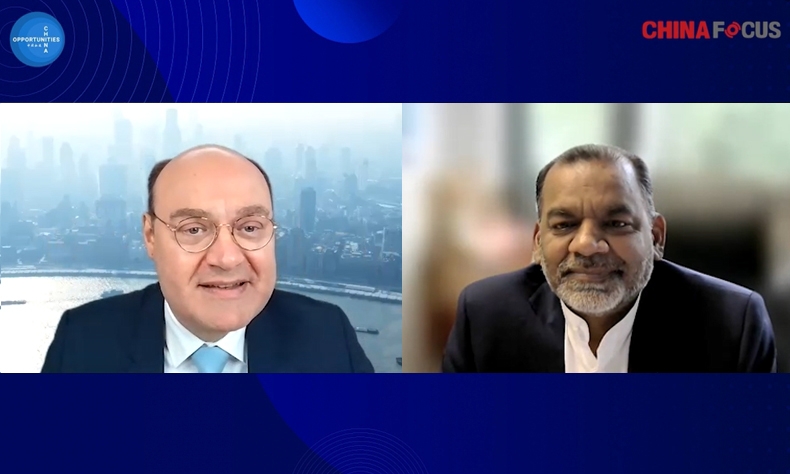
China, Southeast Asia and the RCEP
When you bring China into the picture as a large market, not just as a supply chain, but also as a consumption powerhouse today, definitely, China is going to be a huge opportunity for businesses in Southeast Asia.
Editor’s Note: China, as the second largest economic powerhouse, plays an increasingly important role in building regional free trade partnership. How should the Southeast Asia see China’s opportunity in trade? David Gosset, the founder of Europe-China Forum, discussed with Dr. Bala Louis Ramasamy who is professor of Economics, Associate Dean and Director of GEMBA Program at CEIBS. Dr. Ramasamy gives his insight into the trade relations between China and Southeast Asia, and the prospects of Regional Comprehensive Economic Partnership (RCEP) in Asia-Pacific region.
China Opportunities, hosted by Mr. Gosset, is a global dialogue with senior officials, business elites and distinguished people. The serial interviews are coproduced by China Focus and DG2CI Limited in association with Academy of Contemporary China and World Studies.
David Gosset: Southeast Asia matters. I wanted to ask you, professor, do you think that the Chinese success is seen, from a Southeast Asia perspective, as an opportunity?
Dr. Bala Louis Ramasamy: Definitely, an opportunity, but I think we must understand ASEAN, and the ASEAN Free Trade Area that was established in early 2000. The objective was really to build a large market, one single market in a sense, because this is a market with 650 million people. But I have to say what was hoped and what happened, I would say maybe this is not consistent, because in my opinion, that idea of having a large market did not really materialize, because if you look at this intra-ASEAN trade, trade among ASEAN countries, it has never gone above 25 percent. And even within that 25 percent, most of the trade is among three countries, Malaysia, Singapore and Thailand. So, I think in that sense, also a reason for this really is probably because these countries very much have similar economic structure. So, for example, they export pretty much the same thing, they export oil, they export commodities like palm oil, they export manufactured goods, chips, resistors, and so on. In that sense, they were not complementing each other that much. But when you bring China into the picture as a large market, not just as a supply chain that China has been for many years, but also China as a consumption powerhouse today, definitely, China is going to be a huge opportunity for businesses in Southeast Asia.
David Gosset: Thank you very much. So, it leads us to a second very important question, the RCEP, because now we have this very important agreement, which is going to start to be a reality in several months, and I wanted to ask you, why do you think the RCEP is extremely significant?
Dr. Bala Louis Ramasamy: If (we say) NAFTA, the North American Free Trade Area or the US-Mexico-Canada trade agreement now, if that is for North America and the European Union is for Europe, then RCEP is for Asia. It is by Asia, for Asia. Now really, it’s a pity that India pulled out towards the last minute, but India still has a kind of an open door whenever they want to be part of this RCEP. RCEP is important because this combines Southeast Asia, ASEAN, and then you have this very powerful Northeast Asia, basically, China, Japan, South Korea, and then you have Australia, New Zealand in the south. It combines these three, let’s say, economic centers of Asia together. Now, obviously, China already has a trade agreement with ASEAN, the China-ASEAN Free Trade Agreement. But I think one of the important things with RCEP is this China-Japan-South Korea combination, because they have been trying for many years to have an agreement among the three, but I don’t think this has progressed to completion, but with RCEP, of course it brings these three countries together as well into that common block. Obviously, RCEP is about trade, it’s about investment, it’s even about IP. So, in that sense, I think RCEP is a fantastic opportunity definitely for businesses, but I think also, we should look at RCEP as a way international relations can be managed within the region.
David Gosset: Thank you very much. Clearly, RCEP, these are four letters that we are going to hear again and again in the coming months, years, if not decades, this is extremely significant. And then the last question, what does it mean, this RCEP, for Western businesses? Would you see that as an opportunity for the Western businesses?
Dr. Bala Louis Ramasamy: I would think that for Western businesses, European, American businesses, other businesses, I think if they’re already in Asia, this is going to be a big advantage to you, because it is about combining markets, it’s about rationalizing your supply chain and so on. If you are not in Asia yet, in my opinion, you have missed about. I think in that sense, many of these Western businesses are already operating either in China or Southeast Asia or in both places. I think for those companies, I think RCEP ensures that not just the market is, in a sense, larger, but I think it is also about how they can rationalize their production in such a way that you have both the production bases and the consumption bases within one particular region.
David Gosset: Thank you very much for repeating again the fact that the Chinese economic reemergence is an opportunity for Southeast Asia and for telling us that one needs to pay attention to this RCEP, a very powerful new trade and investment agreement and potentially also a bridge between the region and the West, because you mentioned Japan and Australia. So, thank you very much for this very rich conversation.
 Facebook
Facebook
 Twitter
Twitter
 Linkedin
Linkedin
 Google +
Google +










